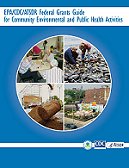Community Action for a Renewed Environment (CARE)
EPA and CDC Collaborate to Support Communities
You will need Adobe Acrobat Reader to view the Adobe PDF files on this page. See EPA's PDF page for more information about getting and using the free Acrobat Reader.
On July 18, 2007, EPA joined forces with the Centers for Disease Control and Prevention (CDC) and the Agency for Toxic Substances and Disease Registry (ATSDR) to support community environmental and health goals. Former EPA Administrator Stephen Johnson and CDC Director Julie Gerberding signed a formal Memorandum of Understanding (MOU) (PDF) (6pp, 278k) to better coordinate the efforts and resources of the agencies, and announced four pilot projects across the country.
The MOU outlines a collaboration that will work with state, local, tribal and community groups to achieve the environmental and public health goals of the agencies. Below is general background information about EPA and CDC efforts to provide support to communities as well as information about four pilot project communities.
Background Information
EPA and CDC manage a number of community-based programs. EPA has expertise in identifying and managing environmental exposures; CDC has expertise in developing health assessments, monitoring exposure, and health education. Some EPA community-based programs, such as CARE, are already working together with CDC and local health departments to provide support to communities. More information about CDC collaboration with EPA.
Joint Publications
 |
Federal Grants Guide (PDF) (29pp, 543k) - a guide jointly developed by EPA, CDC and ATSDR on current funding opportunities available to groups interested in improving the environmental health of their communities. | |
| (PDF, 29pp, 543k) |
Pilot Project Communities
The July 2007 MOU calls for EPA and CDC to work together to improve collaboration in support of communities. The first four pilot communities announced were:
- Boston, Massachusetts
- Cerro Gordo, Iowa
- Cherokee Nation, Oklahoma
- Savannah, Georgia
As of fall 2007, Cerro Gordo withdrew their participation as a pilot community. Kent County, Michigan will be the fourth pilot instead.
Boston, Massachusetts -- EPA and CDC staff will collaborate with the Boston Public Health Commission on its Safe Shops project, ![]() designed to reduce emissions from the estimated 600 auto shops clustered in low-income neighborhoods. EPA funds the testing of safer alternatives to toxic materials, and health and environmental education for shop workers. CDC funds a variety of health-related projects including a mobile health van that provides health screenings to targeted auto body and repair shop workers.
designed to reduce emissions from the estimated 600 auto shops clustered in low-income neighborhoods. EPA funds the testing of safer alternatives to toxic materials, and health and environmental education for shop workers. CDC funds a variety of health-related projects including a mobile health van that provides health screenings to targeted auto body and repair shop workers.
Information on Boston's CARE project.
Cherokee Nation, Oklahoma -- Various communities within the 14 counties in northeast Oklahoma that make up the Cherokee Nation will collaborate to identify sources of toxic exposure and improve the environment. The Cherokee Nation works in collaboration with the Cherokee Nation Clinics and Indian Health Service Hospitals to provide screening and early detection in breast and cervical cancer. EPA and CDC will assist this community in their efforts to improve environmental health.
Information about Cherokee Nation's CARE project.
Kent County, Michigan -- EPA and CDC staff will collaborate with the Kent County Health Department, West Michigan Environmental Action Council and local organizations on the Greater Grand Rapids Children’s Health Initiative to implement on-the-ground efforts to reduce health risks to children from their homes. Kent County Health Department recently received a CDC Environmental Health Capacity Building grant and a partnership including West Michigan Environmental Action Council received an EPA 2007 CARE grant. This collaborative effort will identify successful programs working to reduce environmental risks to children, further improve local capacity, and improve health outcomes at the local level. The project will educate the community at large and will use a "Healthy Homes" approach, which focuses on helping families reduce children’s exposure to toxics such as lead, carbon monoxide, radon, other indoor pollutants and mercury. Improved children’s health will be promoted through education, monitoring, and affordable remediation.
Information about West Michigan’s CARE project.
Savannah, Georgia -- ATSDR is conducting public health activities in the Hudson Hill, Woodville and West Savannah neighborhoods, in response to local residents’ health concerns about increases of cancer, respiratory illnesses, asthma, and skin rashes. ATSDR’s activities include two health consultations, community updates, and health education workshops. Through ATSDR’s petition process, the first completed health consultation summarized available health data from EPA, CDC, the Georgia Environmental Protection Division and the International Paper Company related to community concerns regarding air pollutants released by International Paper. The second health consultation evaluates potential air pollution pathways and is expected to be available for public comment later in 2007. As part of the pilot, EPA, CDC and ATSDR staff will work to build community capacity to address health issues that arise through ATSDR’s public health consultation processes. ATSDR will assist the communities with developing partnerships with industries, businesses, and federal, state and local agencies.
Information about Savannah's CARE project.
More information about EPA's Community Action for a Renewed Environment program.
Read what the Centers for Disease Control and Prevention has written about this collaboration.
